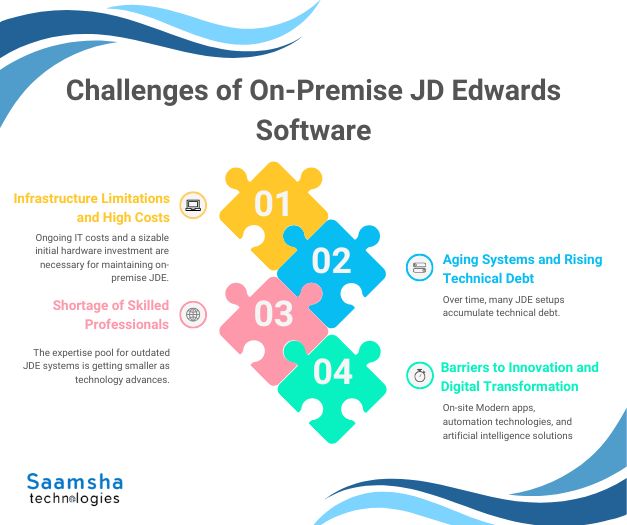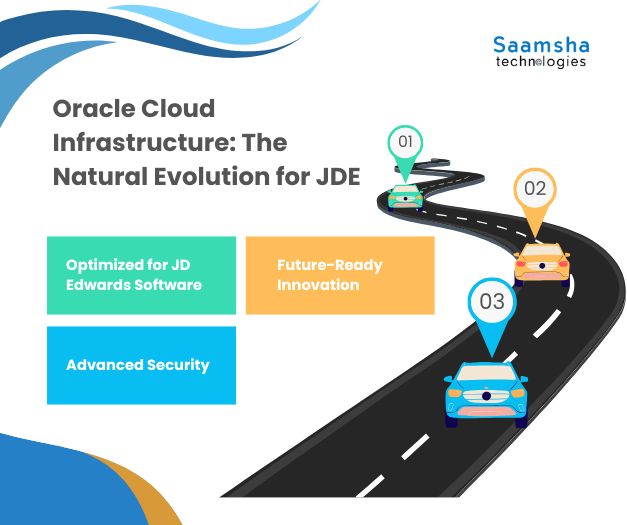The enterprise software industry is undergoing rapid change as more companies adopt cloud-based systems to stay competitive. For JD Edwards (JDE) users, this shift presents a significant opportunity and is also a necessary step.
Traditional on-premise JDE setups no longer meet today’s needs for flexibility, speed, and innovation. The future of JDE lies in the cloud, where businesses can access powerful tools like AI, automation, and real-time analytics, leveraging the core features of JD Edwards software.
Challenges of On-Premise JD Edwards Software
Before going ahead with the future evolution, let’s start by understanding the challenges of On-Premise JDE:
- Infrastructure Limitations and High Costs
Ongoing IT costs and a sizable initial hardware investment are necessary for maintaining on-premise JDE. Operations become less adaptable when scaling amid seasonal peaks or unforeseen demand.
- Aging Systems and Rising Technical Debt
Over time, many JDE setups accumulate technical debt. Upgrades are made more difficult by customization, which render systems antiquated and vulnerable to threats because of a lack of maintenance and updates.
- Shortage of Skilled Professionals
The expertise pool for outdated JDE systems is getting smaller as technology advances. Organizations are finding it challenging to maintain obsolete systems as many specialists switch to cloud-native alternatives.
- Barriers to Innovation and Digital Transformation
On-site Modern apps, automation technologies, and artificial intelligence solutions are challenging to integrate with JD Edwards ERP. This results in lost chances for data-driven decision-making, decreased productivity, and slowed digital transformation.
At Saamsha Technologies, we support organizations on their JD Edwards transformation journey with our expertise. Our blended delivery model ensures 24/7 support, cost efficiency, and reliable execution. Contact us now!

Key Advantages of Cloud Migration with JD Edwards Software
- Migrating JD Edwards to the cloud changes it from a fixed, costly setup into a flexible platform that drives business growth and innovation.
- The most significant benefit is improved scalability, which allows resources to be adjusted in real-time according to business needs, without the limitations of physical hardware.
- Companies using JD Edwards ERP on Oracle Cloud Infrastructure experience a 44% faster deployment of new applications and services, enabling them to respond quickly to market opportunities.
- Moving to the cloud also significantly reduces costs. On average, companies lower their total cost of ownership by 38% after migrating JD Edwards to the cloud.
- Businesses no longer need to invest in expensive hardware, pay for maintenance contracts, or manage complex infrastructure.
- Performance also improves with cloud-based JD Edwards. It has better system availability and stronger disaster recovery to keep the business running smoothly.
- Cloud Migration with JD Edwards software enables reduced downtime, faster processing speeds, and the ability to access the system 24/7 from anywhere, on any device.
Oracle Cloud Infrastructure: The Natural Evolution for JDE
Oracle Cloud Infrastructure (OCI) is the preferred foundation for JD Edwards transformation. Built with JDE compatibility in mind, OCI delivers superior performance, seamless deployment, and unified support.
- Optimized for JD Edwards Software
Preconfigured JDE environments on OCI simplify deployment, reducing migration complexity and time to completion.
- Advanced Security
OCI enforces strict identity controls, encryption, and automated compliance updates, which are essential for industries handling sensitive data.
- Future-Ready Innovation
OCI integrates with Oracle’s expanding suite of AI, machine learning, and automation tools. Companies can adopt hybrid or multi-cloud models while maintaining flexibility for future technologies.
Migrating JDE to OCI future-proofs investments and aligns businesses with Oracle’s long-term roadmap.
AI and Automation: The Future of JD Edwards
- Oracle’s AI strategy transforms JD Edwards from a traditional ERP into a smart business platform by integrating AI features directly into SaaS apps that seamlessly integrate with current JDE processes.
- Oracle Cloud Infrastructure offers advanced AI and machine learning tools that improve data analysis.
- JD Edwards Orchestrator enables businesses to create automated workflows that effectively leverage these AI tools.
- AI automates tasks such as invoice processing and approvals, saving time, reducing errors, and ensuring compliance.
- Predictive analytics enable more effective forecasting of demand and inventory management, ultimately lowering costs and enhancing service.
- AI-powered chatbots offer users quick assistance, alleviating the burden on support teams and enhancing the overall user experience.
- This provides organizations with valuable insights to identify new market trends and enhance their supply chains, enabling them to stay ahead of competitors.

Oracle Cloud Infrastructure: The Natural Evolution for JDE
When planning JD Edwards (JDE) transformation, Oracle Cloud Infrastructure (OCI) emerges as the natural choice. But why? Here are the reasons:
- JDE-optimized: Preconfigured environments guarantee quicker deployments and lower migration barriers.
- Advanced Security: OCI protects critical company data with encryption, identity controls, and automatic compliance.
- Future-Ready Innovation: Businesses stay ahead of the curve when AI, machine learning, and automation are seamlessly integrated.
- Flexibility: Businesses can adjust as technology advances thanks to hybrid and multi-cloud capabilities.
Organisations may align with Oracle’s long-term plan and future-proof their ERP investment by moving from JDE to OCI.
How Saamsha Technologies Can Help You With JD Edwards Solutions
At Saamsha Technologies, we use our strong Oracle JD Edwards skills to help organizations work smarter and faster.
Our experienced team focuses on implementing, improving, and supporting both JD Edwards EnterpriseOne (E1) and World Software applications.
Our affordable support model blends offshore and onsite teams. We are here to help you reduce costs while providing reliable 24/7 technical support and maintenance.
Final Word
JDE Release 25 shows Oracle’s strong commitment to JD Edwards in the cloud, with support and updates planned until 2036.
This release introduces enhanced automation, streamlined workflows, and a more seamless user experience. This made JD Edwards a modern platform that supports digital transformation.
Today, companies must adopt cloud-first strategies to stay competitive. Moving to the cloud early enables businesses to become more agile, reduce costs, and leverage advanced technologies.
The real question is not whether companies should move to the cloud, but how quickly they can make the switch to stay ahead.



